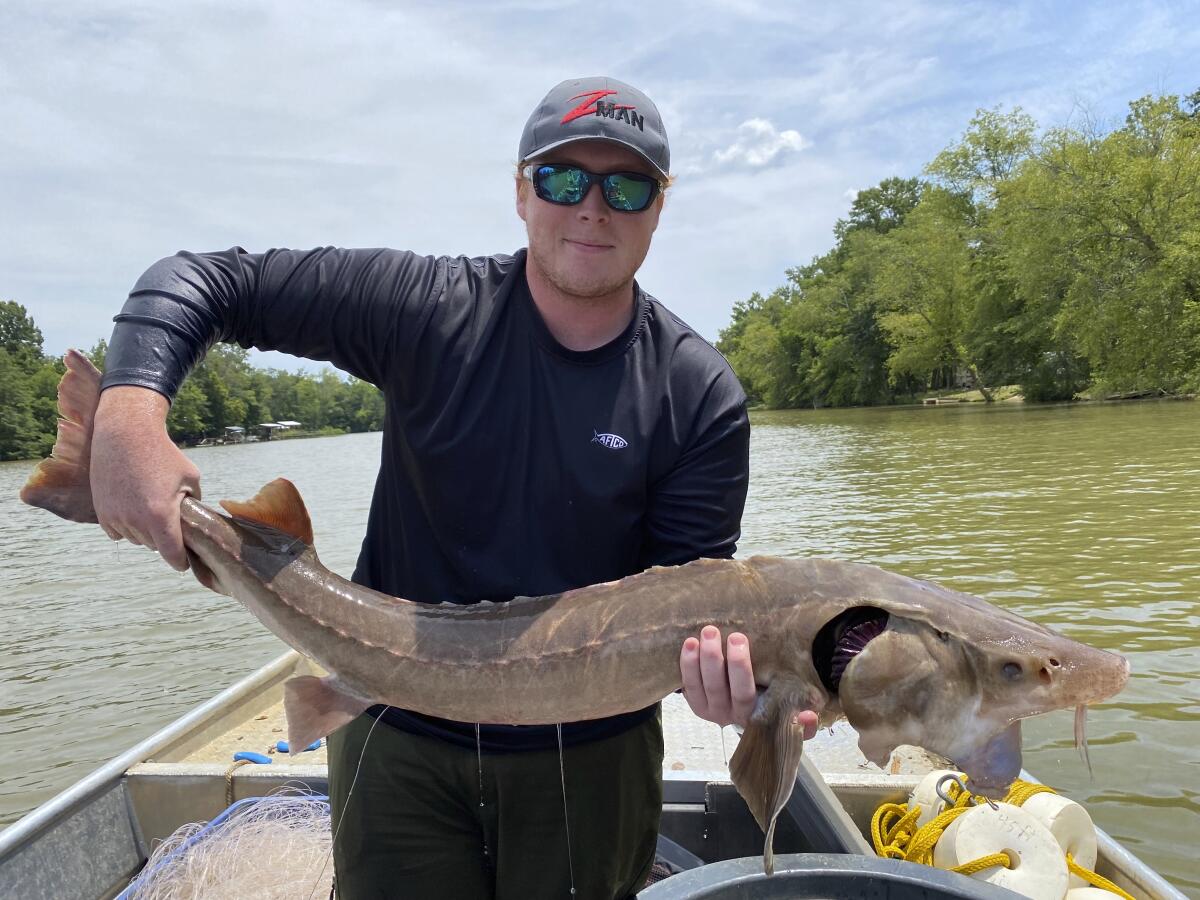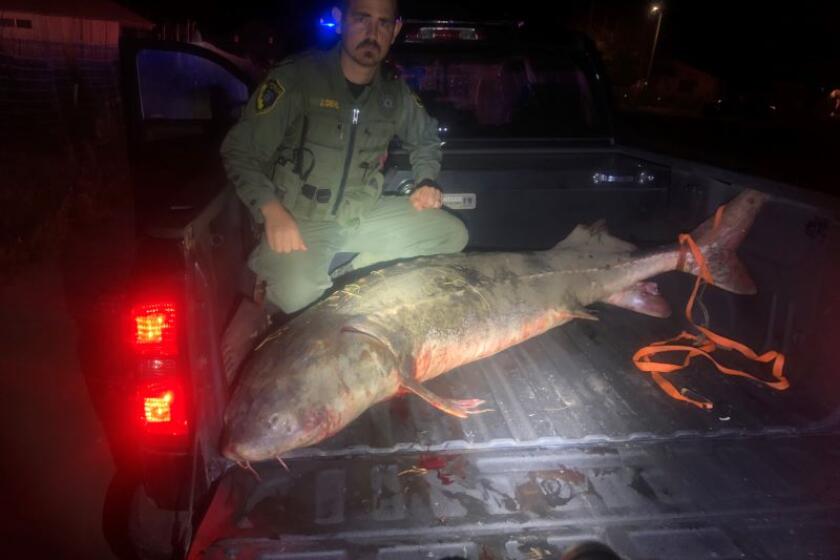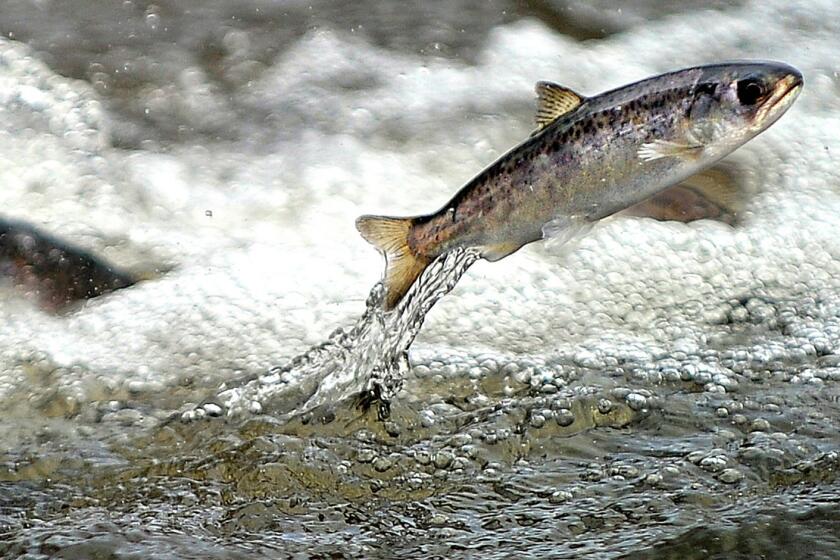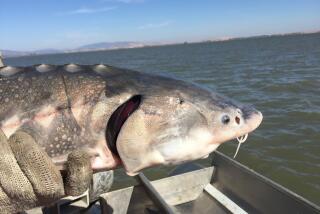A prehistoric fish may be spawning in Georgia for the first time in 50 years

- Share via
Scientists and students embarking on a census of Georgia lake sturgeon have found three females with mature eggs — an indication that the armored “living fossils” may be reproducing in the state for the first time in half a century.
“It’s exciting because it’s confirmation that they are becoming mature and trying to spawn,” Martin J. Hamel, an associate professor at the University of Georgia Warnell School of Forestry and Natural Resources, said in a recent news release.
Fossils indicate that the spade-nosed fish with a bottom-mounted vacuum hose instead of jaws has existed for more than 136 million years, scientists say.
One of nine sturgeon species and subspecies found in the U.S., lake sturgeon live in 18 states and five Canadian provinces in the St. Lawrence, Hudson Bay, Great Lakes and Mississippi River watersheds, according to the U.S. Fish and Wildlife Service.
Pollution, habitat destruction and harvesting for flesh and caviar have so diminished their numbers that the U.S. Fish and Wildlife Service is considering federal protection for the species.
Sturgeons’ bone-plated bodies did so much damage to fishing nets that commercial fishers hauled large numbers out in the 1800s, the Minnesota Department of Natural Resources recounts on its website.
Nine people were arrested by state wildlife police on suspicion of poaching, selling animals on the black market and other offenses.
Dams, which keep the big fish from migrating from lakes to the rivers where they spawn, also reduced their numbers. Now lake sturgeon are at less than 1% of historical levels.
By the 1970s, lake sturgeon had been wiped out of northwest Georgia’s Coosa River basin — the only place where they were found in Georgia.
State protections, such as fishing limits, and stocking programs, some run by Native American tribes, have helped sturgeon.
The state Department of Natural Resources began reintroducing lake sturgeon 20 years ago, after the Clean Water Act cleaned up the river, Hamel said.
Rising demand from unwitting consumers, local greed amid a failing economy, weak controls and corrupt law enforcement are driving the Danube’s last wild sturgeons to the brink of extinction.
Females take 20 to 25 years to mature and produce the black, glistening eggs that people love to eat, according to Michigan Sea Grant. Until such eggs turned up this year in females implanted with radio telemetry tags to track their movement, nobody knew whether Georgia’s sturgeon were surviving long enough to reproduce.
“Because lake sturgeon take a long time to mature and then reproduce intermittently — every two to three years — we really need a robust population of varying size and age classes,” Hamel said.
The current population assessment is the largest since Georgia first collected eggs from fish in Wisconsin, raised them in a hatchery and released them into the Coosa in 2002. State natural resources staff, working with their Wisconsin counterparts, have done so nearly every year since.
“It’s a big investment because you don’t even know if the stocked fish are going to survive, let alone grow up and reproduce,” Hamel said.
The fish, which died of chlorine exposure, included green and white sturgeon and chinook salmon that were being studied at the facility.
About 330,000 fish, most about six inches long, have been released since 2002, Hamel said in an email.
“While that seems like a lot of sturgeon, the survival rate of fish that are released at that size is likely between 1-10%,” he wrote.
The students are catching as many lake sturgeon as they can to estimate population size, survival and growth rates. The project started in the spring. It will run through this summer and next spring and summer, finishing in winter 2023, Hamel wrote.
Information from the first three years of restocking suggested that sturgeon juveniles were surviving.
Start your day right
Sign up for Essential California for the L.A. Times biggest news, features and recommendations in your inbox six days a week.
You may occasionally receive promotional content from the Los Angeles Times.
“There’s been a lot of questions about long-term survival, growth rates, and when these fish would become sexually mature — and we’re on the verge of determining if these fish are going to successfully reproduce,” Hamel said.
The oldest lake sturgeon on record was 152 years old, according to the Fish and Wildlife Service. The agency says the fish can reach up to nine feet long and 310 pounds.
The largest caught so far by the Georgia group was 52 inches long and weighed 24 pounds.
“This is the largest fish that anyone has documented on the Coosa River,” Hamel wrote.
More to Read
Sign up for Essential California
The most important California stories and recommendations in your inbox every morning.
You may occasionally receive promotional content from the Los Angeles Times.













